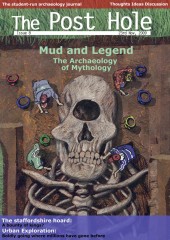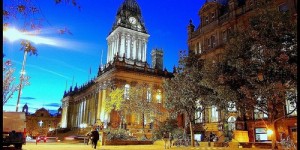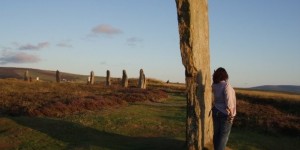[The realm of myth and magic] is a dangerous field: fairies abound, good fairies and bad fairies, dragons and dragon-slayers, gods and goddesses, truth and untruth, history and legend, science and fiction, inextricably mixed and fused. But what has archaeology to do with it, you will say? Archaeology is concerned with bones and flints, with pots and pans and post-holes, with stone and metal, in short, with the material remains and spades to dig them up with.
(Tritsch 1970, 1)
## What is a Myth? Myth (noun)
- A traditional or legendary story, usually concerning some being or hero or event, with or without a determinable basis of fact or a natural explanation, esp. one that is concerned with deities and demigods and explains some practice, rite, or phenomenon of nature
- Stories or matter of this kind: realm of myth.
- Any invented story, idea or concept: His account of the event is pure myth.
- An imaginary or fictitious thing or person
- An unproved or false collective belief that is used to justify a social institution.
A myth, a mere story, can seem to be far from a resource that we, as members of the increasingly scientifically-minded discipline of archaeology, would deign to utilise. Yet myths are not always as grounded in the realms of fantasy as they might seem, at first glance, to be. In the course of this article I hope to 'explore the possibilities of developing an interdisciplinary dialogue, and making this dialogue fruitful to the future development of both disciplines' (Gazin-Schwartz and Holtorf 1999, 4). In order to accomplish this, two case studies will be analysed where mythology has had an impact on archaeology, in two very different ways. Firstly, there is the case of Troy, where the work of a Grecian poet has informed the archaeology of a site in Turkey, and secondly, the site of Cossington in Leicester, where an excavation has unearthed evidence of mythology in practice. And perhaps, somewhere along the way, you will come to believe that the union of archaeology and mythology is far from being grounded in the world of fairytales... ## Troy The city of Troy, and the associated Trojan war, has been the subject of European mythology for over three thousand years (Latacz 2004, vii). Troy and the Trojan war are, of course, famous for their being the focus of the Iliad, a poem composed in about 700 B.C. by the Grecian, Homer (Latacz 2004, 3), a work which first sparked the mythological status of the city. The poem itself was composed about 450 years after the fall of Troy, and some of the many questions that both historians and archaeologists alike have asked concern the extent to which Homer's work can be regarded as historically correct, and whether the current archaeological site of Hisarlık on the Dardanelles, is indeed the 'Troy' of Homer's Iliad (Latacz 2004, 2-3).
It is argued that Hisarlık, or Troy's, 'connection with myth, the world of imagination and illusion, is the very origin of archaeology as a scientific discipline' (Korfmann 2007, 23), the intrigue and mystery surrounding the city and its past, driving archaeologists to find new ways to uncover its secrets. Despite this, however, the excavations undertaken at the city have never been aimed towards 'contributing answers to questions about the Iliad or the Trojan War' (Korfmann 2007, 23), indeed it has often been the deliberate intention of those working on the site to keep the two, the myth and the archaeology, separate as a matter of principle (Korfmann 2007, 23). While the Iliad may not, therefore, be a source of information about the city of Troy at the time that Homer's poem is set, it does nonetheless provide us with an insight into what the ruins of Troy must have looked like some 450 years later, when Homer was composing the Iliad (Korfmann 2007, 23). Indeed, it stands to reason that 'Homer and those from whom he may have derived some of his information are witnesses of what the topographical setting and life in the late eighth century B.C. were like' (Korfmann 2007, 23), as Homer's audience would have had access to the impressive ruins of Troy, as they stood then, and would have needed to recognise in those ruins the Troy of Homer's Iliad. Therefore, the myth of Troy inspired subsequent archaeological investigations and it has even been postulated that it was instrumental in the emergence of archaeology as a scientific discipline. Furthermore, while the direct excavation of the purported site of Troy and its relation to the myth inspired by Homer's Iliad have been deliberately kept separate, the Iliad has nonetheless proved to be archaeologically informative in at least one regard, that of how the site of Troy appeared topographically in the eighth century B.C. and provided a limited insight into daily life at that time. ## The Cossington Round Barrows An illustration of the creation of myth in archaeology can be found slightly closer to home in the example of the use and re-use of three Bronze Age round barrows at Cossington, in Leicestershire. Of the three barrows found at the site, Barrow 3 alone appears to have been the focus of later attention, having formed the 'focus for Iron Age settlement and ... [been] clearly referenced in the laying out of several later prehistoric land boundaries' (Thomas 2008, 129). It was also the focus of a more spiritual form of attention, as there is a tradition of deliberate deposits on the site that persists well into the Roman period (Thomas 2008, 129). These deposits are interpreted as being 'carefully negotiated interactions with the barrow, either in deference to its association with the supernatural or as a way of manipulating the past to mark associations with the 'ancestors'' (Thomas 2008, 129).
In the later Anglo-Saxon period, following Barrow 3 as the focus of the Iron Age settlement, the monument was restored to its original relationship with the dead and reinstated as a burial ground (Thomas 2008, 129). John Thomas states that it is likely that this later phase of re-use stems from either 'a desire to be associated with a mythical past to create a sense of place in the landscape (Bradley 1987), or to invent specific histories for local communities (Williams 2006, 183)' (cited in Thomas 2008, 129). Therefore we can see that, even without the glamour and instant sense of intrigue and fascination aroused by the myth surrounding Troy, landmarks such as round barrows within the British landscape were a focus for the mythology of later peoples, seeking to associate themselves with the 'ancestors' who created such monuments. The change in usage from their initial creation as places of burial, to being the focus of settlement in a later period and then returning once again to their original function provides us with a wonderful illustration of how the myth surrounding a monument or site can be changed and moulded over time, not only by the selectivity of what is accurately remembered and transmitted through the ages, but also by the desires and motives of those who follow, whether they are invaders striving to assert their claim over the land or simply those who want to associate themselves more strongly with the peoples who preceded them. Indeed, John Thomas summarises the situation eloquently when he states that 'the memories and mythologies involved in the life stories of the monuments provides a reflection of changing attitudes as occupation of the landscape increased. It is clear that the monuments held high importance to their creators and rather than becoming static landmarks of past occupation, their significance was retained, remembered, and redefined by later groups wishing to stake a claim on the Cossington landscape' (Thomas 2008, 129). ## Conclusion Archaeology and mythology are two fields that it can seem almost impossible to combine — the material, earthly remains that we can find, study and catalogue versus the ephemeral, long-distant interpretations and stories concerning people and places that can seem to have lost all meaning in the modern world. Yet the two are more intrinsically linked than they seem — the two case studies shown here demonstrate two very different ways in which archaeology and mythology can be seen to compliment one another.
In the case of Troy, we can see that the ancient work of Homer has informed archaeologists about a period in history they otherwise would have known little about, and possibly even inspired the very scientific nature of the discipline. Furthermore, in the case of the Cossington round barrows the archaeology itself has informed us about the mythology surrounding the later re-use of the site. In these two ways, mythology informing archaeology and archaeology informing mythology, we can see a fascinating relationship forming. One thing to take away from this paper, if nothing else, is that archaeology isn't a dead and dry subject, concerned purely with material remains — we need to see beyond the bones, broken pots and barrows that we find and into the lives that they could have lived through the centuries — we need to look for the archaeology of mythology. ## Bibliography
- Anon (n.d.) 'Myth' http://dictionary.reference.com/browse/myth, page accessed 16/11/09.
- Bradley, R. (1987) 'Time regained: the creation of continuity'. Journal of the British Archaeology Association 140, 1-17.
- Gazin-Schwartz, A. and Holtorf, C.J. (1999) ''As long as ever I've known it...': on folklore and archaeology' in A. Gazin-Schwartz and C.J. Holtorf (eds) Archaeology and Folklore, 3-20. London, Routledge.
- Korfmann, M.O. (2007) 'Was There a Trojan War?' in M.M. Winkler (ed) Troy: From Homer's Iliad to Hollywood Epic, 20-27. Oxford, Blackwell Publishing.
- Latacz, J. (2004) Troy and Homer: Towards a Solution of an Old Mystery. Oxford, Oxford University Press.
- Thomas, J. (2008) 'Conclusion — Monument, Memory and Myth' in J. Thomas (ed) Monument, Memory and Myth: Use and Re-use of Three Bronze Age Round Barrows at Cossington, Leicestershire, 127-129. Leicester Archaeology Monograph 14, University of Leicester Archaeology Services.
- Tritsch, F.J. (1970) Myth, Magic and Archaeology. Pamphlet of an inaugural lecture delivered by Professor F.J. Tritsch in the University of Birmingham on 8 December 1970. Birmingham, University of Birmingham.
- Williams, H. (2006) Death and Memory in Early Medieval Britain. Cambridge, Cambridge University Press.






